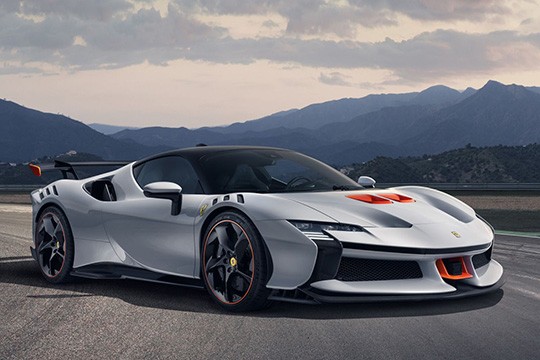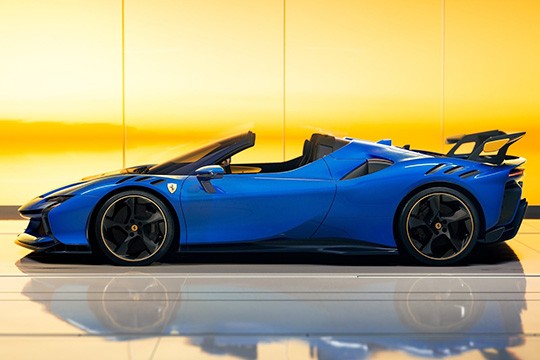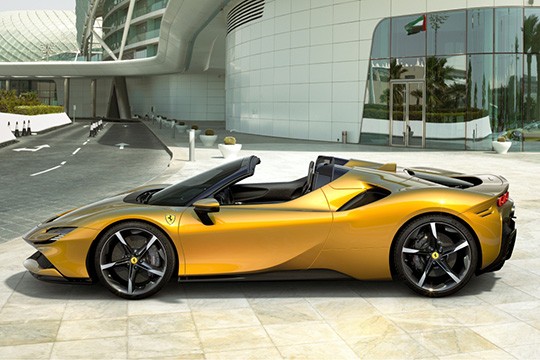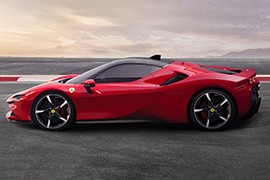FERRARI SF90 Models/Series Timeline, Specifications & Photos
First production year: 2019
Engines: Hybrid gasoline, Hybrid
Body style: Coupé (two-door)
Ferrari unveiled during a private event held on their home track at Fiorano the SF90 XX in both versions: the Stradale, which is the coupe, and the Spider, which is the open-top version of it. The new model comes as an addition to the SF90 lineup and is aimed at those who are spending some time on a track, not just on regular roads.
The car was developed under the XX Programme, previously focused only on vehicles built for race tracks. But then, the program evolved and started to enhance production models, such as the Ferrari FXX-K EVO. Nevertheless, the team noticed that its customers started to ask for road-legal high-performance vehicles, so it came up with this: the SF90 XX Stradale. A 799-unit production for a high-performance vehicle made for tracks, but able to wear license plates on it.
The team started off with a production SF90, which they enhanced it in all areas. As a result, the SF90 XX Stradale features a new nose fitted with a wider and lower splitter. In addition, the Z-shaped LED headlights were connected on their lower side with a pair of air intakes made to cool the front brakes. On the upper side of the front fenders, Ferrari installed a set of vents to enhance the car's aerodynamic shape. Moving on to the sides, there are new carbon fiber side skirts that are extended on the rear quarter panels. In addition, there are air intakes on both sides of the greenhouse, but those are needed to cool the engine. Last but not least, Ferrari installed a rear wing supported by two goose-neck-style struts.
Inside, everything is designed around the driver. Ferrari installed a pair of sports seats with high bolstered areas. Despite the fact that they looked like unadjustable racing ones, they could recline. Between them, the car manufacturer installed a light center tunnel where the buttons for the gear selector were placed but were moved forward compared to the SF90. The cockpit also featured a simple-looking dashboard that Ferrari covered in Alcantara on the upper side to reduce glare, while the lower side was cushioned with fabric for a softer touch.
Ferrari installed a plug-in hybrid system for the vehicle that featured a twin-turbo V8 internal combustion engine helped by three electric motors. As a result, the combined power of these elements reached 1030 PS (1016 HP). The ICE alone provided 797 of them, while the rest was ensured by the electric motors. Since Ferrari developed the car as a plug-in hybrid, it also ensured a large enough battery pack that allowed the vehicle to run for up to 25 km (15.5 miles) in EV mode at speeds of up to 135 kph (84 mph).
Ferrari has a long history of producing open-top vehicles. As a matter of fact, the first car that wore the ramping horse badge was installed on a roadster. So, the Italian car manufacturer continued on doing so with most of the cars it produced. As a result, there was no surprise to see next to the SF90 Stradale, the open-top version of it, traditionally named Spider.
When Ferrari created the XX Program, it made it to create bespoke vehicles made for track for its special customers. Later on, the same team that developed those cars was tasked to create an advanced version of the SF90 hypercar. Their mission was to create a race-ready vehicle but to feature enough elements that could make it road-legal. That's how the SF90 XX Stradale and the SF90 XX Spider were born.
The Spider featured a similar-looking front fascia like its Stradale sibling, with a slim line that crossed the car from side to side. Underneath that, the carmaker installed a splitter with an additional lip underneath it. In the center, Ferrari installed the radar in the center for advanced safety systems. The slim LED headlights were extended on their outer sides by air intakes that channeled the air around the bodywork to lower the drag resistance. From its profile, the SF90 XX Spider kept the overall look of the SF90 Spider but with several modifications. Behind the cockpit was the engine's air intake, and on top of the fenders, a set of vents extracted the air trapped inside the wheel well to diminish the lift effect created by that. Finally, at the back, an adjustable wing adorned the engine's cover.
Ferrari installed two sports seats inside the SF90 XX Spider's cockpit. These were made on a carbon fiber frame and padded with Alcantara. Between the driver and the side passenger, the car featured a lightweight center console fitted with the buttons for the transmission. These were moved forward compared to those installed on the regular SF90 lineup. Fronting the driver was a completely digital instrument cluster that boasted not just the tachometer and the speedometer but also various data about the car, needed especially for on-track use. But despite being a track-oriented car, it still had some road-oriented features, such as a sound system. Ferrari made the roadster with a retractable top that could disappear behind the cabin in a mere 14 seconds at speeds of up to 45 kph (28 MPH).
Ferrari installed a plug-in hybrid system for the vehicle that featured a twin-turbo V8 internal combustion engine helped by three electric motors. As a result, the combined power of these elements reached 1030 PS (1016 HP). The ICE alone provided 797 of them, while the electric motors ensured the rest. Since Ferrari developed the car as a plug-in hybrid, it also installed a large enough battery pack that allowed the vehicle to run for up to 25 km (15.5 miles) in EV mode at up to 135 kph (84 mph).
Ferrari unveiled the SF90 Spider in November 2020 in an online event so all of its fans could see how the future roadster supercar looks like for the Italian manufacturer.
Ferrari launched its first PHEV (plug-in hybrid electric vehicle) in 2019. In the following year, the carmaker introduced the open-top version for the supercar. The name SF90 came from the 90th anniversary of the Scuderia Ferrari (their competition department). The technology pack was impressive for any sportscar fan, and the performance results matched the vehicle's look.
Due to its aerodynamic package, the front grille installed on the lower side was used to cool the motors and the battery pack. Behind the cabin, two large air-intakes did the same thing for the engine. The roof was retractable behind the cabin, in a split and tilting movement, under a panel to provide an authentic open-air driving. At the back of the car, the spoiler provided additional downforce by lowering its front part.
Inside, the dashboard was focused around the driver, with a completely digital panel in the instrument cluster. Ferrari installed thin carbon-fiber sport-bucket seats with enough padding for comfort but high bolstering for high-speed cornering.
The three electric motors used offered a total output of 220 hp. Two of them were used for the front wheels, and the third helps the V8 to power the rear wheels. The SF90 Stradale can be driven in EV mode, up to 25 km on a charge. The electric motors could power the car at speeds up to 134 kph (84 mph) with a longitudinal acceleration of under 0.4g. The gearbox featured eight forward gears. For reversing, the car used the front electric motors.
The first Ferrari PHEV (plug-in hybrid electric vehicle) was launched in 2019. A new chapter with new possibilities was open and its figures of 1000 hp shocked everyone.
The name SF90 comes from the 90th anniversary of the Scuderia Ferrari (their competition department). The technology pack is impressive for any sportscar fan. The 4.0-liter V8 engine obtained 780 hp with help from a turbo. The rest of the 220 hp was given by the three electric motors installed to help the car's launch. Since the SF90 was a turning point in the brand's history, it was also equipped with an AWD system. Even if it is not the first AWD Ferrari, it was the first Ferrari sports car with an all-wheel-drive. And the results were matching the look of the vehicle.
Only 2.5 seconds were needed to do a 0-100 kph (0-62 mph) sprint. The strange 8-speed gearbox installed didn't have a reverse gear. An electric motor was used for the reverse.
The three electric motors used offered a total output of 220 hp. Two of them were used for the front wheels and the third helps the V8 to power the rear wheels. The SF90 Stradale can be driven in EV mode, up to 25 km on a charge. The electric motors can be used at speeds up to 134 kph (84 mph) with a longitudinal acceleration of under 0.4g. That means, basically, at a constant speed.



